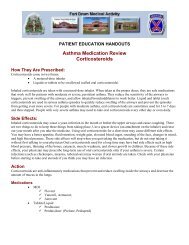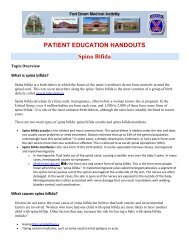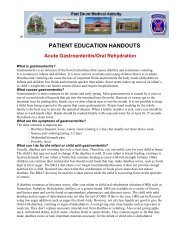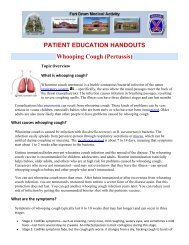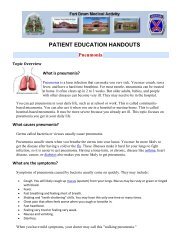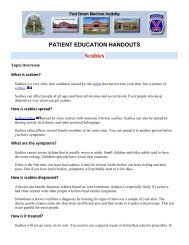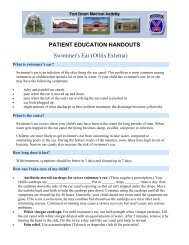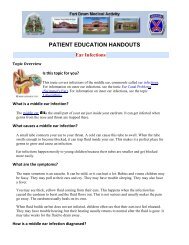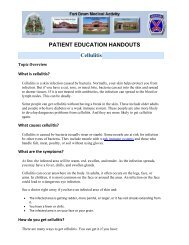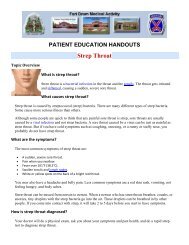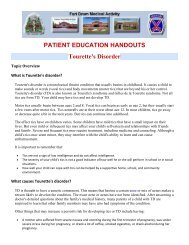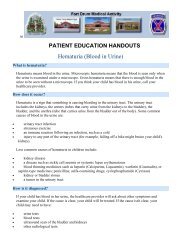Pinworms
Pinworms
Pinworms
- No tags were found...
Create successful ePaper yourself
Turn your PDF publications into a flip-book with our unique Google optimized e-Paper software.
PATIENT EDUCATION HANDOUTS<strong>Pinworms</strong>What is a pinworm?A pinworm is a white, very thin worm about 1/4 inch long that moves. If it doesn't wiggle, it's probably lintor a thread. <strong>Pinworms</strong> usually are seen in the anal and buttock area, especially at night or early in themorning. Sometimes a pinworm is found on the surface of a bowel movement. More than 10% of childrenhave pinworms. They do not cause any serious health problems. However, they can cause much itchingand irritation of the anal area and bottom.How do I check for pinworms?If your child has itching or irritation of the anal area, he could have pinworms. Keep in mind that many getitching in this area just from washing the area too often or vigorously with soap.Check your child for pinworms as follows: First, look for a 1/4-inch, white, threadlike worm that moves.Examine the area around the anus using a flashlight. Do this a few hours after your child goes to bed andfirst thing in the morning for 2 nights in a row. If no pinworm is seen, do a Scotch tape test for pinwormeggs.Instructions for Scotch tape test1. Pick up glass slides at your healthcare provider's office (2 for each child) and write your child's name onthe slides.2. Touch the sticky side of a piece of clear Scotch tape to the skin on both sides of the anus. Do this in themorning soon after your child has awakened and before any bath or shower.3. Stick the piece of tape onto a slide. Do this 2 mornings in a row. Be sure to wash your hands right afterhandling the tape. Bring the slides to your provider's office. Your child's provider will look at the tape undera microscope.Your provider will call you to give you the results. If pinworm eggs are seen on the slides, your child'sprovider will prescribe medicine.How can I take care of my child?• Anti-pinworm medicine If you have definitely seen a pinworm, your child needs to be treated withmedicine. You can buy a nonprescription medicine, or contact your healthcare provider for a prescription.The pinworm medicine is called _________________________. The dose is _________, given__________________.
• Treatment of other family members for pinworm Children are usually infected by children outsidethe family. If anyone else in your family has itching and irritation in the anal area, or anyone sleeps withyour child, call your healthcare provider during office hours for instructions. Your provider will tell you if itis necessary for everyone in the family to be treated. If any of your child's friends have similar symptoms,be sure to tell their parents to get them tested. Dogs and cats do not carry pinworms.What if my child was exposed to another child with pinworms?If your child has been around a child who has pinworms but has no symptoms, your child probably won'tget them. <strong>Pinworms</strong> are harmless and are never present very long without causing some anal itching. If youwant to be sure your child doesn't have pinworms, wait at least a month. A swallowed egg will not matureinto an adult pinworm for 3 to 4 weeks. Then contact your provider about doing a Scotch tape test forpinworm eggs.How can I help prevent pinworms?Infection is caused by swallowing pinworm eggs. Your child can get pinworms no matter how carefullyyou keep your child and your house clean. The following hygiene measures, however, can help to reducethe chances of reinfection of your child or new infections in other people.• Have your child scrub his hands and fingernails thoroughly before each meal and after each use of thetoilet. Keep the fingernails cut short because eggs can collect under the nails. Discourage thumbsucking andnail biting.• Vacuum or wet mop your child's entire room once a week because any eggs scattered on the floor areinfectious for up to 2 weeks.• Disinfect the toilet seat.• Kill any eggs on clothes, pajamas, underwear, or bedding by machine-washing in hot water daily for 2weeks.When should I call my child's healthcare provider?Call during office hours if:• The skin around the anus becomes red or tender (strep bacteria can infect this area).• The anal itching does not stop within 1 week after treatment.• You have other concerns or questions.Published by McKesson Corporation.This content is reviewed periodically and is subject to change as new health information becomes available. The information isintended to inform and educate and is not a replacement for medical evaluation, advice, diagnosis or treatment by a healthcareprofessional.Written by B.D. Schmitt, M.D., author of "Your Child's Health," Bantam Books.Copyright © 2007 McKesson Corporation and/or one of its subsidiaries. All Rights Reserved.Copyright © Clinical Reference Systems 2008Pediatric Advisor
_________________________________________________________________________________________________Reviewed 9 June 2008



